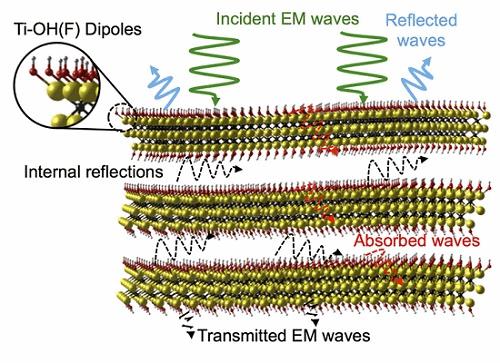2D Nanomaterial MXene Outperforms Graphene In EMI Shielding

By Jof Enriquez,
Follow me on Twitter @jofenriq

Researchers at Drexel University and the Korea Institute of Science & Technology have developed a spray coating made of the two-dimensional nanomaterial MXene that they claim is more effective at blocking electromagnetic interference (EMI) than graphene, carbon fibers, and copper or aluminum foils.
MXenes are a new family of 2D transition metal carbides and/or nitrides discovered and being developed by Drexel researchers. Multilayer MXenes are electronically conductive — with conductivity similar to multilayer graphene — and could be used for a wide range of applications including electronic devices, sensors, reinforcement for composites, and energy storage materials.
Copper or aluminum foils and carbon-polymer composites are in widespread use as shielding material against EMI, but they also add considerable size to the device or apparatus they protect. For instance, currently used carbon-polymer composites add about one millimeter to the size of an iPhone, which is about 7 mm thick.
“In general, adequate shielding can be achieved by using thick metals, however, material consumption and weight leave them at a disadvantage for use in aerospace and telecommunication applications. Therefore, it is of great importance to achieve better protection with thinner films,” said Babak Anasori, Ph.D., a research assistant professor in the A.J. Drexel Nanomaterials Institute, according to a Drexel news release.
The researchers experimented with different thickness of MXene films, ranging from a couple micrometers (one-thousandth of a millimeter) up to 45 micrometers, just slightly thinner than a human hair. The thinnest film was found to be roughly equal to conventional copper and aluminum foils in their shielding effectiveness. MXene films thickened up to 8 micrometers achieved 99.9999 percent blockage of radiation with frequencies covering the range from cell phones to radars. In their tests, the thin samples of MXene outperformed other synthetic materials such as graphene or carbon fibers.

As published in the journal Science, the Electromagnetic Interference Shielding with 2D Transition Metal Carbides (MXenes) study abstract provides some technical details: “A 45-micrometer-thick Ti3C2Tx film exhibited EMI shielding effectiveness of 92 decibels (>50 decibels for a 2.5-micrometer film), which is the highest among synthetic materials of comparable thickness produced to date. This performance originates from the excellent electrical conductivity of Ti3C2Tx films (4600 Siemens per centimeter) and multiple internal reflections from Ti3C2Tx flakes in free-standing films.”
Electromagnetic waves bounce off the surface of the MXene films, and those that don’t are trapped between the internal layers of the material and subsequently absorbed.
When combined with a polymer solution, MXene can also be used be applied as a spray coating, which is potentially useful for protecting wearables and other portable devices where size and weight are critical.
“This finding is significant since several commercial requirements for an electromagnetic interference shield product are engrained in a single material,” said Yury Gogotsi, Ph.D., Distinguished University and Trustee Chair professor in the College of Engineering and director of the A.J. Drexel Nanomaterials Institute. “MXene displays many of these characteristics, including high shielding effectiveness, low density, small thickness, high flexibility and simple processing. So it is an excellent candidate for use in numerous applications.”
Image source: Drexel University
